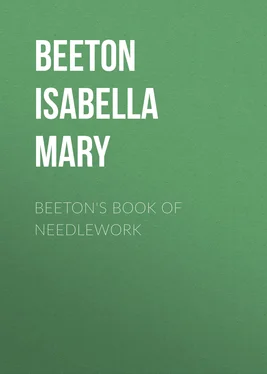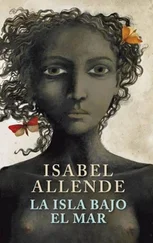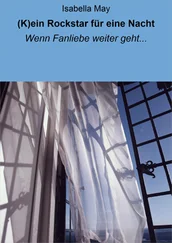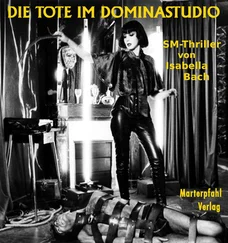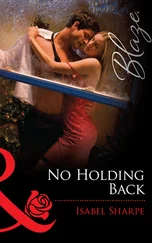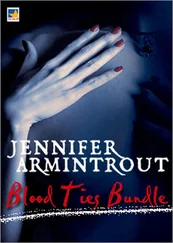Isabella Beeton - Beeton's Book of Needlework
Здесь есть возможность читать онлайн «Isabella Beeton - Beeton's Book of Needlework» — ознакомительный отрывок электронной книги совершенно бесплатно, а после прочтения отрывка купить полную версию. В некоторых случаях можно слушать аудио, скачать через торрент в формате fb2 и присутствует краткое содержание. Издательство: Иностранный паблик, Жанр: foreign_antique, foreign_home, Хобби и ремесла, на английском языке. Описание произведения, (предисловие) а так же отзывы посетителей доступны на портале библиотеки ЛибКат.
- Название:Beeton's Book of Needlework
- Автор:
- Издательство:Иностранный паблик
- Жанр:
- Год:неизвестен
- ISBN:нет данных
- Рейтинг книги:5 / 5. Голосов: 1
-
Избранное:Добавить в избранное
- Отзывы:
-
Ваша оценка:
- 100
- 1
- 2
- 3
- 4
- 5
Beeton's Book of Needlework: краткое содержание, описание и аннотация
Предлагаем к чтению аннотацию, описание, краткое содержание или предисловие (зависит от того, что написал сам автор книги «Beeton's Book of Needlework»). Если вы не нашли необходимую информацию о книге — напишите в комментариях, мы постараемся отыскать её.
Beeton's Book of Needlework — читать онлайн ознакомительный отрывок
Ниже представлен текст книги, разбитый по страницам. Система сохранения места последней прочитанной страницы, позволяет с удобством читать онлайн бесплатно книгу «Beeton's Book of Needlework», без необходимости каждый раз заново искать на чём Вы остановились. Поставьте закладку, и сможете в любой момент перейти на страницу, на которой закончили чтение.
Интервал:
Закладка:
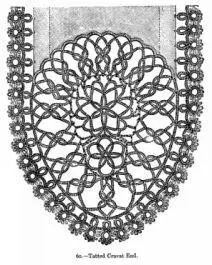
Work then the 2nd round over the cotton on the 2nd shuttle, beginning to work where the two ends of cotton have been fastened, * 6 double, 1 purl, 5 double, fastened on to the purl of the next scallop of the preceding round, 5 double, 1 purl, 6 double fastened on to the cotton between two scallops of the preceding round; repeat 5 times more from *. The larger rosette is now completed. The smaller rosette is worked like the first, only without the second round. The insertion-like border is worked in two halves as follows:–The half which touches the edge of the medallion is worked as follows:–Knot both ends of cotton together and *, work with 1 shuttle only 1 circle consisting of 8 double, 1 purl one-fifth of an inch long, 8 double; turn the circle downwards and work close to it over the cotton on the 2nd shuttle 6 double, 1 purl, 6 double; this forms a scallop of the border. Then turn the work again and work close to the scallop another circle like the first, but which is fastened on to the first circle instead of working the purl. Turn the work again, work a scallop like the preceding one, and repeat 15 times more from *, only the scallops at the lower edge of the medallion must have a few double stitches more, as can be seen in illustration. After working the last scallop fasten the two ends of the cotton on to the 1st circle; then cut them off. The second inner half is worked like the first; only the circles are worked without any purl stitch, and fastened on to the circles of the first half from illustration; the scallops of this half are somewhat smaller; each consists of 5 double, 1 purl, 5 double. The completed border is sewn on to the rosettes from illustration; the different pieces must be first fastened on cardboard. The cotton must be wound several times round the long threads, as seen in illustration. The medallion is then sewn into the muslin at the top only; the remaining border is edged, before joining it to the muslin, with a straight row of knots to be worked over cotton, and fastened on to each outer scallop of the border at regular intervals. The number of double stitches between two purl is different, as distinctly seen in illustration. For the lace knot both ends of cotton together, * work with one shuttle only 1 circle consisting of 8 double, 1 purl, 8 double; turn the work and make another circle consisting of 2 double, 9 times alternately 1 purl, 2 double; then fasten this circle on to the preceding one, where it has been joined into a circle, so that both circles meet as seen in illustration. After having turned the work again, work 9 double over the cotton on the 2nd shuttle, which form a scallop between the circles, and repeat from *. The lace is then sewn round the edge of the muslin.
61.– Rosette in Tatting and Embroidery .
Materials: Messrs. Walter Evans and Co.'s tatting cotton No. 60, or No. 40 if desired in a larger size.
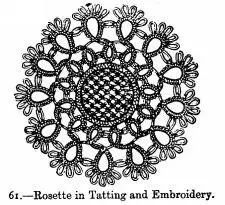
This rosette is suitable for ornamenting lingeries, cravats, &c.c. It is worked in white embroidery and lace stitch, and edged all round with a tatted lace. For the latter work with very fine cotton * 1 large circle, consisting of 5 double, 1 purl, 7 times alternately 2 double, 1 purl, then 5 double. At a short distance from this circle work a smaller one, consisting of 5 double fastened on to the last purl of the large circle, 5 double. Leave again an interval as small as the last, and repeat from * 11 times more. But in working the large circles, instead of working the 1st purl, fasten them on the same purl of the large circle on which the small circle has been fastened; besides this, in working the last (12th) large circle, instead of working the last purl, fasten it on the 1st purl of the 1st circle; the last small circle is fastened on to the same purl. The lace is thus joined into a circle, and is sewn round the outside of the rosette with button-hole stitches.
62– Cravat End in Tatting .
Materials: Messrs. Walter Evans and Co.'s tatting cotton No. 60; tatting-pin No. 3.
The illustration shows the end of a tatted cravat. Work first the middle row of the cravat at the same time with the row of circles on the left side of the middle row in illustration; begin with the first circle of the middle row. It consists of 7 times alternately 3 double, 1 small purl, then 3 double. Work close to this circle, which must be turned downwards, a Josephine knot, consisting of 5 plain stitches, then a circle consisting of 5 double, 1 purl one-fifth of an inch long, 5 times alternately 3 double, 1 small purl; 3 double, 1 long purl, 5 double. *Turn this circle (which is the first of the side row) downwards, work close to it a Josephine knot, then a circle consisting of 12 double, 1 small purl, 12 double. Turn this circle downwards, work a Josephine knot, and then again a circle like the first of the side row, but instead of working the first long purl, fasten it on to the last purl of the preceding circle of the same row. Then hold the work so that the circles of the side row are turned downwards, work a Josephine knot, 1 circle like the first circle of the middle row, turn the work, make 1 Josephine knot, and then a circle like the second circle of the side row. Repeat from * till the cravat is sufficiently long. The last circle of the middle row must correspond to the first circle of the same row. Then begin to work the lower edge at the same time with the last circle of the middle row, * 1 Josephine knot, then a circle like the circles of the side row, again 1 Josephine knot, fastened on to the next purl of the last circle of the middle row; repeat 3 times more from *. Then continue as before, and work on the right side of the middle row a row of circles exactly like those which have been worked at the same time with those of the middle row.
The fastening on of the cotton between two Josephine knots is seen in illustration. The circles at the other end of the cravat are fastened like those of the first-described end. The cravat is edged all round with a row of circles with Josephine knots worked exactly like those of the preceding row, and the manner of fastening which is seen in the illustration.
63.– Rosette in Tatting and Embroidery .
Materials: Messrs. Walter Evans and Co.'s tatting cotton No. 60, or 40 if required larger; tatting-pin No. 3.
The centre of this rosette is worked in lace stitch on muslin, edged round with button-hole stitch and trimmed with a tatted lace, which is worked at the same time with the centre. Work first * a small circle consisting of 5 double, 1 purl, 3 double, fastened on to the button-hole stitch edging of the rosette, then 3 double, 1 purl, 5 double. Then turn the just-completed circle downwards, and afterwards work at a short distance a large circle consisting of 7 double, 6 times alternately 1 purl, 2 double, lastly 1 purl, 7 double, then 1 Josephine knot consisting of 7 plain. Then turn the work again, so that the last large circle is turned downwards, and repeat from * 12 times more; the large and small circles must be fastened on to one another, as seen in illustration. The fastening of the small circles on to the centre is likewise done from the illustration.
64.– Cravat End in Tatting and Darned Netting .
Materials: Messrs. Walter Evans and Co.'s tatting cotton No. 50; tatting-pin No. 3; square of netting; fine Mecklenburg thread No. 80.
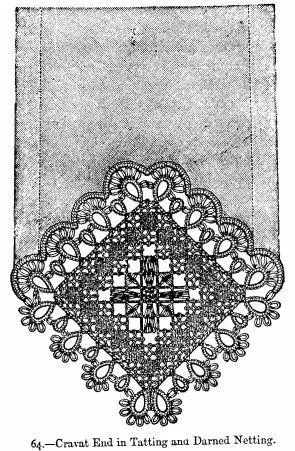
The end of this cravat is ornamented with a square of darned netting, edged with a tatted border, and sewn on to the material of the cravat. But the diamond in tatting (page 18), or the square (page 31) will look very pretty with this border. The square is worked in diamond netting, and has seven holes in length and breadth. They are darned in linen stitch, darning stitch, and point d'esprit , with Mecklenburg thread. The ground is worked over a mesh measuring three-tenths of an inch round. For each square one more row than is needed must be worked, and the cast-on stitches are cut off, as they are longer than the stitches of the other rows. The tatted border is worked with fine tatting cotton. Fasten the cotton at one corner of the square and work * a circle consisting of 7 double, 1 purl, then six times alternately 2 double, 1 purl, 7 double, fasten the cotton on to the same stitch of the ground where it was first fastened; #work a second circle like the first, but fasten it, instead of working the first purl on to the last purl of the preceding circle; fasten the cotton again on to the same stitch, then on to the next stitch, and work a small circle, consisting of 5 double fastened on to the last purl of the preceding circle, 4 double, 1 purl, 5 double. The cotton is fastened on to the same netted stitch as before, and then on to the next stitch; repeat twice more from #, and then repeat from * in all three times more, so that the square is edged all round. It is sewn into the material from the illustration.
Читать дальшеИнтервал:
Закладка:
Похожие книги на «Beeton's Book of Needlework»
Представляем Вашему вниманию похожие книги на «Beeton's Book of Needlework» списком для выбора. Мы отобрали схожую по названию и смыслу литературу в надежде предоставить читателям больше вариантов отыскать новые, интересные, ещё непрочитанные произведения.
Обсуждение, отзывы о книге «Beeton's Book of Needlework» и просто собственные мнения читателей. Оставьте ваши комментарии, напишите, что Вы думаете о произведении, его смысле или главных героях. Укажите что конкретно понравилось, а что нет, и почему Вы так считаете.
